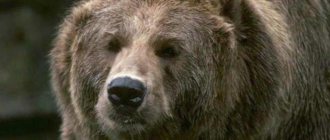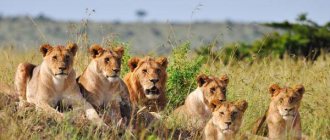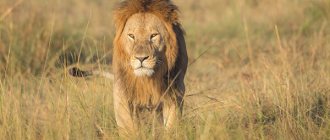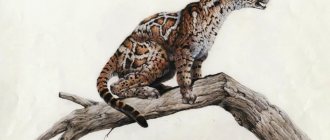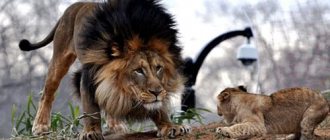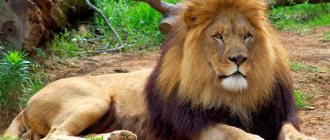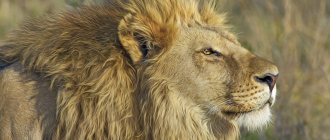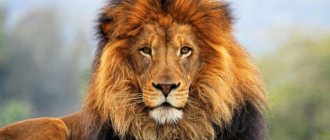The lion is a large and powerful predator, a member of the cat family. This is one of the strongest and most powerful cats on Earth, second only to the Amur tiger in size, but on the African continent you cannot find a larger cat. Therefore, in culture, lions began to be considered the real “kings of all animals,” and they gained their fame since time immemorial, constantly appearing in various legends of peoples. This is a unique animal in many ways.
The biggest difference between a lion and other cats is their sociability and sociality; they live in groups called prides. Lions are part of the big cat family, which means both males and females can roar. This is a diurnal animal, but if necessary due to danger, it easily adapts to the night, having excellent night vision. It has been on the IUCN Red List since 1996, as lion numbers have declined by 43% since the 1990s.
Lions are a widely recognized animal symbol - they have often been and continue to be used in various sculptures and paintings, on national flags, in films and literature.
Scientists have found images of lions dating back to the early Paleolithic; and the figurines and pictures found in the Lascaux and Chauvet caves in France were created as much as 17,000 years ago. During the heyday of the Roman Empire, lions were kept in menageries, and since the late 18th century, these huge cats have become the main attraction in many zoos around the world. Interesting fact : lions are the only cats that live in groups.
Description of lions
Description of lions
Appearance of lions
Appearance of lions
Appearance of lions
Appearance of lions
The lion is a muscular cat with a compact body, a large head and short legs, the front of which are distinguished by their power. Lions' teeth and jaws are designed for hunting. The mouth has 30 teeth, which include 4 fangs and 4 teeth designed for cutting flesh. Size and appearance vary greatly between the sexes - so it is very easy to distinguish males from females.
Lion's mane
The main characteristic feature of the male is his mane, which is different for each individual: it can be very small, it can cover the muzzle, it can be huge and thick, covering the neck, head, shoulders, chest and continue along the stomach. It is believed that the thickness and size of the mane primarily depends on the genes, health and amount of testosterone of each individual individual. It is because of this feature that lions appear much larger than their size, which is very helpful in nature, scaring off other predators or representatives of their own species who are potential competitors. Some lions have dark, almost black manes - this gives the cats an incredibly majestic appearance, so it’s not for nothing that they are nicknamed “the kings of all animals.”
Wool
Overall the fur is yellow-gold. The fur is short, the tail is long and has a dark tuft of hair at the end. There are no markings in the form of stripes or spots, like other cats, on the bodies of lions, and if there are, they are weakly expressed. This helps large predators remain invisible in savannas.
Interesting fact : without fur, the bodies of lions and tigers are so similar that only experts can tell them apart.
Lion size and weight
Lions are very large cats, they reach a height of 1.2 meters at the shoulders, body length is usually around 3 meters, and the tail is from 60 to 91 centimeters. Male lions weigh from 150 to 250 kilograms . Females are much smaller - they grow up to 2.7 meters and weigh from 120 to 180 kilograms.
Interesting fact : The white lion is a rare mutation of the common lion with a genetic disorder called leucism, which is caused by a double recessive allele. This is not an albino; He has normal pigmentation in his eyes and skin.
Features of lion anatomy
Lions have three types of teeth
- The incisors, small teeth at the front of the mouth, grasp and tear meat.
- The fangs, the four largest teeth (on both sides of the incisors), reach a length of up to 7 cm, tear the skin and meat.
- Carnivores have their sharpest teeth at the back of their mouths, acting like scissors for cutting meat.
Paws and claws
The paws are similar to a cat's paws, but much, much larger. They have five toes on their front feet and four on their back feet. A lion's paw print will help you guess how old the animal is, whether it is male or female.
Lions release their claws. This means that they stretch out and then retract, hiding under the fur. The claws grow up to 38 mm in length, are strong and sharp. The fifth toe on the front paw is vestigial, acts like a human thumb, and holds prey while eating.
Language
A lion's tongue is rough as sandpaper and covered with spines called papillae, which face backward and scrape meat from bones and dirt from fur. These spines make the tongue rough; if a lion licks the back of the hand several times, it will be left without skin!
Fur
Lion cubs are born with grayish fur, with dark spots covering most of the back, paws and face. These spots help the hatchlings blend in with their surroundings, making them almost invisible in bushes or tall grass. The spots disappear at about three months, although some last longer and continue into adulthood. During the teenage stage of life, the fur becomes thicker and golden in color.
Mane
Between 12 and 14 months of age, male cubs begin to grow long hairs around their chest and neck. The mane lengthens and darkens with age. In some lions it passes through the stomach and onto the hind legs. Lionesses do not have manes. Mane:
- protects the neck during combat;
- repels other lions and large animals such as rhinoceroses;
- is part of the courtship ritual.
The length and shade of a lion's mane depends on where it lives. Lions living in warmer climates have shorter, lighter-colored manes than those in colder climates. The color changes as there are temperature fluctuations throughout the year.
Mustache
The sensory organ near the nose helps to sense the environment. Each tendril has a black spot at the root. These spots are unique to each lion, just like fingerprints. Since no two lions have the same pattern, researchers use them to distinguish animals in nature.
Tail
The lion has a long tail which helps with balance. The lion's tail has a black tassel at the end, which appears between 5 and 7 months of age. The animals use the brush to guide the pride through the tall grass. Females raise their tails, give the “follow me” signal to their cubs, and use it to communicate with each other. The tail conveys how the animal feels.
Eyes
Lion cubs are born blind and open their eyes when they are three or four days old. Their eyes start out blue-gray and turn orange-brown at two to three months of age.
A lion's eyes are large with round pupils that are three times larger than human pupils. The second eyelid, called the nictitating membrane, cleans and protects the eye. Lions do not move their eyes from side to side, so they turn their heads to look at objects to the side.
At night, the covering on the back of the eye reflects moonlight. This makes a lion's vision 8 times better than a human's. The white fur under the eyes reflects even more light into the pupil.
Scent glands
Glands around the chin, lips, cheeks, whiskers, tail and between the toes produce oily substances that keep the fur healthy and waterproof. Humans have similar glands that make hair oily if you don't wash your hair for a while.
Sense of smell
A small area in the mouth area allows the lion to “sense” odors in the air. By showing their fangs and sticking out their tongues, lions detect a scent to see if it's coming from something worth eating.
Hearing
Lions have good hearing. They turn their ears in different directions, listen to rustling sounds around them, and hear prey from a distance of 1.5 km.
Habitat of lions
Habitat of lions
Scientists have found evidence of lions living almost throughout Africa, in some parts of Europe and Asia. During the Pleistocene era (from 2,600,000 to 11,700 years ago), lions spread throughout North America and Africa, the Balkans, and also through Anatolia and the Middle East to India. Genetic studies suggest that the lion evolved in eastern and southern Africa, diverging into a number of subspecies such as the Barbary lion (Panthera leo leo) in North Africa, the cave lion (P. leo spelaea) in Europe, and the American lion (P. leo atrox) ) from North and Central America and the Asiatic lion (P. leo persica) from the Middle East and India - dating back to 124,000 years ago.
Barbary lion
Habitat reduction
Lions disappeared from North America about 10,000 years ago, from the Balkans about 2,000 years ago, and from Palestine during the Crusades. By the 21st century, their numbers have dropped to several tens of thousands, and those individuals that are still found outside national parks are rapidly losing their habitat due to agricultural development. Currently, the main stronghold of the lion's range is in sub-Saharan Africa, and the Asiatic lion exists only as a remnant population of approximately 300 individuals inhabiting India's Gir National Park on the Kathiawar Peninsula.
Lions today remain only in isolated areas, which are just a drop in comparison with the range of the past. African lions are found only in small areas of sub-Saharan Africa, while a small population of Asiatic lions lives in a remote part of the Gir Forest in India. Despite the negative influence of humans and decline in numbers due to the destruction of their natural habitat, lions are extremely adaptable animals, able to survive in very dry climatic conditions, obtaining most of their moisture from food . Lions have been found in tropical forests (although they are not fans of very humid climates), and in extremely dry deserts. But still, these huge cats prefer to live in areas of open forest and large meadows, where they can not only find shelter among trees or in tall grass, but also a lot of food.
Conflicts that arise between local people and lions are the most serious problem in conserving the lion population. It is the villagers who are the main reason for the decline in the lion population. But despite such problems, lions remain the main attraction of many reserves, where their lives flourish. Although zoologists note that the increase in the number of lions can negatively affect local agriculture and also become a threat to other animals, including the cheetah.
Reproduction
Lion cubs and mother
Mating games among lions occur over several days a year. Males often fight for females.
Both sexes are generally polygamous, but females are often limited to one or two males from their pride. In captivity, mating can occur every year, but in the wild this period is usually longer - once every two years. Females are ready for them three to four days a year; during this period, couples engage in mating games up to 50 times a day, each of which lasts from 20 to 30 minutes.
Lionesses and lions reach the age of maturity at 2-3 years, but despite this they will not participate in mating games until their relationship in the pride is finally established. It is interesting to note that all the females in the pride give birth at approximately the same time, this helps them fight to establish the hierarchy that exists among the males, playing the same roles. They help each other care for the cubs and are ready to feed any family kitten who asks.
Females give birth once every two years, giving birth to one to four cubs. Pregnancy lasts three and a half months. Kittens are born blind and very weak, making them extremely vulnerable. The fur of lion cubs is covered with black spots, which disappear as they grow up - this helps them hide from insidious enemies while the adults go hunting.
Interesting: The most dangerous fish in the world - a list of why they are dangerous, names, where they are found, photos and videos
What do lion cubs eat?
The cubs feed on mother's milk for the first six months, but already from three months they begin to eat meat. By 11 months, kittens already begin to participate in hunting, but rather in a playful mode, without bringing any real benefit. This becomes the most important lesson on the difficult path of growing up. 80% of lion cubs do not survive during the first two years of life - due to hunger, attacks by other predators or male lions that capture prides, displacing weaker predecessors. Only after 2 years will they be ready for independent living. Females are ready to protect their cubs to the last, even from males, but they pay more attention to protecting older ones, who will soon be ready for independent life.
Hunting training
Male cubs are kicked out of the pride at around 3 years of age and become nomads until they are old and strong enough to try to overthrow the head of another pride - this happens at around 5 years of age. But it is worth noting that most males remain nomads for their entire lives, never finding the strength to challenge the leaders.
There are practically no opportunities for single males to engage in mating, and competition between lions is extremely high, which leads to frequent and violent conflicts that can cause fatal injuries.
Lions do not directly participate in the lives of kittens, leaving this role for lionesses. But the lions are busy protecting the pride from competing males, thereby protecting the cubs, which have been defenseless for a long time.
Prides containing 2 to 4 males are more successful in defense and development than smaller groups, allowing them to persist for longer periods. If a new group of males captures a pride, then they seek to get rid of the lion cubs that their predecessors gave birth to - this leads to the fact that the females become ready for mating games.
Natural enemies of a lion
Can anyone in the wild compete with such a strong and powerful animal as a lion? Surprisingly, there are animals ready to challenge the king of beasts himself. So lions sometimes have to fight for their prey, and in some cases, for their own lives.
The main enemy of a lion is another lion
In the wild, the most important and deadly enemy for a lion is its own maned relative. Young strong males leading a solitary lifestyle often try to win a place at the head of the pride by challenging its leader to a fight. And then a fierce battle occurs between the two males, in which both receive injuries and wounds. In the most internecine fighting, lions do not die very often. But because of the injuries received, the losing animal finds it difficult to hunt and defend itself, and it dies of hunger or from the claws and teeth of other predators.
And the main predatory opponents of the lion in the African savannas are, of course, hyenas. Huge cats often take prey from these spotted animals, and hyenas never miss the opportunity to take revenge on them. Yes, even a pack of hyenas has no chance against an entire pride or a healthy young lion. But an animal that is wounded or weakened by hunger becomes their lawful prey. In addition, hyenas attack small lion cubs and lonely lionesses.
A lonely and sick lion becomes easy prey for hyenas
Sick and elderly lions can become victims of another member of the cat family - the leopard. The relationship between these two predators is very strained, because lions not only take hunting trophies from spotted cats, but also kill their cubs. Therefore, when meeting with a wounded maned enemy, the leopard will try to get even for past grievances, and in 50% of cases their fight ends in victory for the leopard.
At a watering hole, a lion can be dragged under water by a large crocodile, although such cases can be considered not a pattern, but an exception to the rule.
How long do lions live?
Life expectancy of lions
In captivity, lions rarely live longer than 10 years, because they often become victims of hunters, external and internal conflicts and prides, as well as from injuries received during hunting (for example, a blow from the powerful hooves of zebras). But in captivity they can live up to 25 years . The oldest recorded individual lived to be 30 years old.
Females live longer than males - they can live up to 15-16 years. Lions reach their peak of maturity between 5 and 9 years of age, when they are most active.
For their Asian counterparts, things are a little different: the mortality rate among lion cubs is lower than that of African ones, and their life expectancy is longer - on average, they live 17-18 years.
Features of the table etiquette of predatory cats
Lions chase their prey for hours, but kill in a matter of minutes. Afterwards, the female emits a low roar, calling on the pride to join the feast. Adult males eat first, then females, then cubs. Lions devour prey within about 4 hours, but rarely eat it to the bone; hyenas and vultures finish the rest. After eating, the lion can drink water for 20 minutes.
To avoid the dangerous midday heat, lions hunt at dusk, when the dim light of the setting sun helps them hide from their prey. Lions have good night vision, so darkness is not a problem for them.
Prides and behavior
Behavior of lions
The uniqueness of lions and the main distinguishing feature from other felines is their social life, which is characterized by the creation of prides. Members of prides live in small groups in which they unite to hunt or share food. Prides consist of several generations of lionesses and a small number of males, as well as lion cubs. Typically groups consist of 4 to 37 individuals, but the average is approximately 15 lions.
Each pride has a strictly limited habitat, which is vigilantly guarded from the invasion of other lions by males, but there are also some kind of buffer zones in which strangers are allowed in, but only for passage or for a short time. Such territories belonging to the pride, in areas with a large amount of food, can reach only 20 square kilometers, but in areas with a meager amount of living creatures, the area can reach 400 square kilometers.
Prides can continue to exist for more than one generation of lionesses, but the heads of prides are replaced approximately every 3-4 years, because there is always a stronger male when the leader begins to lose strength. Lions mark their territory with a loud roar and their scent, spraying bushes and rocks. The characteristic roar of lions is usually heard in the evening before the hunt begins and early in the morning when the pride wakes up at dawn.
Lions have developed strong competition and a strict hierarchy in the pride. Squabbles between males can not only lead to injury, but also become a serious threat to the entire family, as tired defenders will not be able to defend themselves from external danger. Females have no competition or hierarchy. It is interesting to note that males are aggressive towards other members of the pride while eating food, while females willingly share with their relatives.
Defense is mainly carried out by males, but lionesses are also always ready to defend against invasion. Some individuals do this consistently and purposefully, while others are less interested in it. Each lion takes on a specific role, even the slow ones have a specific activity that they diligently perform.
Despite their incredible strength and large size, males practically do not hunt, since they are slower and more noticeable than females due to their size and mane. Females hunt together, which allows them to obtain food in the most efficient way, spending less energy, using developed tactics with which they can kill larger and faster animals.
Socialization of lions
Animals in a calm state, when nothing bothers them, have a wide range of behaviors. Leos have a wide arsenal of gestures and movements with which they can communicate with each other. The most common tactile gestures that are peaceful and friendly are head touching and licking.
These huge cats often sniff each other's foreheads, muzzles and necks when greeting - this can often be seen after a long absence of a separated individual or after a collision with other lions. Males engage in such games with other representatives of their sex, females and cubs only with lionesses.
The most important technique in the socialization of lions is licking, during which the licked clearly expresses his pleasure. The head and neck are the most common parts of the body to be licked. This behavior, some scientists say, arose from an inability to perform such actions ourselves and an inability to reach these areas of the body.
Lions also have a wide arsenal of facial expressions and postures that are gestures for their relatives. The most famous is the “grimace” that is used by the lion when detecting certain scents of other big cats, expressed by opening the mouth, baring the teeth, raising the head, wrinkled forehead, closing the eyes and relaxing the ears.
A wide range of vocal signals is also good for communication: varying intensities and pitches are central tools for lion socialization. Characteristic vocal signals are growls, purrs, panting, bleating and buzzing. The roar acts primarily as a signal of one's presence and dominance, and serves to scare others away. The roar of a lion can be heard at a distance of up to 8 kilometers . They tend to use several deep and long tones, which then fade into shorter ones.
Lion hunt
Lion Hunting
A lion is a large and carnivorous animal that survives only by eating other animals. Unlike other felines, lions are not solitary hunters, but instead lionesses work together to track and capture their prey, as each female plays a different strategic role. This strategy allows them to hunt animals that are both faster and much larger than them. Depending on the abundance and variety of prey species in their territory, lions primarily take gazelle, zebra and warthog, as well as a number of antelope species, following herds through open grasslands.
Who do lions hunt?
Lions hunt a wide variety of animals, from rodents and baboons to buffalo and hippopotamuses, although they generally prefer medium to large ungulates such as wildebeest and zebra. Food preferences may vary depending on the area of residence and each particular pride. Elephants and giraffes are also on the lions' menu, but these are mostly weak and stray individuals. They are willing to eat any meat they can find, including carrion. They also do not hesitate to steal from other predators - hyenas, cheetahs and wild dogs.
Interesting: Manul - description, character, habitat, reproduction, enemies, photos and videos
Lionesses live mainly in savannas and spend most of their time hunting, while the males appropriate the female's prey for themselves. But do not underestimate lions, who are no less mobile than lionesses, they are also dexterous and skillful hunters, who in some regions are often engaged in hunting along with females. Those prides whose territory is located in open forest zones often spend most of their time hunting, obtaining their entire diet on their own, thereby spending significantly less time with females.
While many consider a group of hunting lions to be the most formidable natural force on land, most hunts end in failure. Lions do not pay attention to the direction of the wind, which can carry the smells of predators over long distances, warning potential victims of an impending threat, and they quickly get tired after short runs.
As a rule, lions are in shelter, tracking down prey from there. At the moment when the animal passes close to the shelter, the cat launches its huge body into a dash in order to catch up with its future dinner, but such races are not designed to be long. When a lion catches up with its prey, it lunges at the neck and plunges its fangs, which it does not unclench until it strangles the victim or until the latter is exhausted.
Other members of the pride gather around the carcass and begin to eat together. Sometimes the prey is too small for the entire pride to approach at the same time, and then quarrels can occur, which often end in injury. The cubs are the last to start eating.
When hunting in a group, members of a pride surround large herds of animals, causing panic, due to which the victims are unable to form a defensive structure, becoming more vulnerable. After a successful hunt, lions often spend a couple of days resting. An adult male can eat up to 34 kilograms of meat at a time, and then rest for a week before starting to search for food again. If there are a lot of living creatures in the vicinity of the pride, then both sexes spend hunting almost around the clock, spending only 2-3 hours a day resting.
Interesting fact : Leos love to relax and laze around. They spend 16 to 20 hours every day resting and sleeping. They have few sweat glands, so they wisely seek to conserve their energy by resting during the day and become more active in the evening when it is cooler.
In most cases, lions absorb food on the spot, but sometimes they can drag it to a secluded place. A lioness needs to eat up to 5 kilograms of meat daily for a healthy life. Lions also protect food from other predators.
Hyenas and lions
An interesting relationship has developed between hyenas and lions. Their diet is almost 60% the same. Lions often ignore the presence of hyenas, while the latter have a pronounced reaction to lions in the surrounding area. Lions often take food from hyenas, thereby causing the latter to become more active in response. But hyenas, in turn, often wait on the sidelines of the pride, which is in the process of devouring the next victim, in the hope that after the insatiable lions there will be at least some food left.
These two species can come into conflict for no apparent reason; there is a number of evidence of an attack by a pack of hyenas on a lion. Lions can cause the death of 71% of hyenas. As the lion population in Kenya's Maasai Mara National Reserve declined, the spotted hyena's numbers rapidly increased.
Interesting fact : Experiments on spotted hyenas in captivity show that specimens without prior experience with lions act indifferent to their species, but they react with fear to the scent of a lion.
Lions tend to dominate cheetahs and leopards, taking their prey and killing their cubs and even adults when given the chance. A study in the Serengeti ecosystem found that lions killed at least 17 of 125 cheetah cubs born between 1987 and 1990. Lions also dominate African wild dogs, killing them and preying on young and rarely adult dogs. Lions have been observed killing crocodiles that dare to crawl onto the ground.
Threats
Threats to Lions
Although lions have no natural predators in the wild, statistically, most of the deaths of these graceful felines are due to conflicts between several individuals, as well as at the hands of humans. Lions can often cause serious, often fatal injuries to members of other prides. Wounded lions can become victims of hyenas and leopards, and lions can also be seriously injured during hunting. The cubs can be killed by other predators, and the weakest ones, due to lack of food for the entire pride, are abandoned by the lionesses, which is why they die, unable to independently obtain food or defend themselves.
Ticks often infest lions' ears as well as their groin areas. Some species of tapeworm are becoming a serious threat to these big cats. They enter the intestines due to contaminated antelope meat. The autumn fly led to an epidemic among lions in the Ngorongoro Crater in 1962, which led to the depletion of a huge number of individuals, which were covered with huge bloody spots. Then the lions showed unusual behavior: they tried to protect themselves from flies by climbing trees or climbing into holes dug by hyenas. The number of lions in that region decreased from 70 to 15. A similar outbreak occurred in 2001.
Lions are also at risk of contracting the canine distemper virus, which has been spreading since the 1970s. It moved from local sick dogs to other predators, including big cats. The Serengeti National Park also experienced an outbreak of the canine distemper virus in 1994, during which many lions began to exhibit extremely alarming symptoms, including severe seizures. But these graceful cats are also affected by other diseases - pneumonia or encephalitis. Immunodeficiency or lentivirus also affects lions in captivity.
Nutrition
Lions are predatory animals. As a rule, they hunt in groups, but there are also individuals. Lions often take down prey larger than themselves. Due to their pronounced physique, males find it more difficult to camouflage than females, so in a pride females do most of the prey catching. Males behave more aggressively during feeding than females, although most likely they were not the ones who killed the prey.
African lions feed on the most common large ungulates (Thomson's gazelle (Eudorcas thomsonii), zebra (Equus burchellii), impala (Aepyceros melampus) and wildebeest (Connochaetes taurinus)). Individual prides tend to have preferences for certain animals, such as buffalo (Syncerus caffer) and giraffe (Giraffa camelopardalis). Lions that are unable to capture large prey may temporarily feed on birds, rodents, ostrich eggs, fish, amphibians and reptiles. Lions can also feed on hyenas and vultures.
In the Serengeti National Park in Tanzania, local lions feed on 7 species of animals: zebra (Equus burchellii), wildebeest (Connochaetes taurinus), Thomson's gazelle (Eudorcas thomsonii), buffalo (Syncerus caffer), warthogs (Phacochoerus aethiopicus), cow antelope (Alcelaphus) buselaphus) and topi antelope (Damaliscus lunatus).
Hunting becomes more effective during group attacks. Studies in the Serengeti have shown that an individual succeeds in hunting about 17% of the time, while the group succeeds 30%.
Interaction with people
Interaction with People
Lions have always been fascinated and feared by people, but due to hunting and growing human settlements, many of the lions' natural habitats have been destroyed. Although it has long been known that lions do not see humans as prey, in search of food they can wander into villages, where, due to fear caused by an outlandish environment for a predator, they sometimes behave unpredictably. Therefore, according to statistics, more than 700 people annually become victims of lion attacks, 100 of them die from such contact - this is only in Tanzania. In 1898, two lions in Kenya managed to kill 130 railway workers over a period of 9 months. This behavior is largely due to the fact that lions have been hunted for many centuries, and the instinct of self-defense makes itself felt.
Lion hunting flourished from ancient times and was often considered a royal pastime that symbolized the patriarch's victory over nature itself. The very first source about lion hunting, dating back to 1380 BC, talks about the killing of 102 lions by Pharaoh Amenhotep III “with his arrows” during his 10-year reign.
Lion hunt
The Assyrians released captive lions into a reserved area for the king to hunt; spectators watched the event as the king and his men, on horseback or in chariots, killed the lions with arrows and spears.
Lions were also hunted during the Mughal Empire. In ancient Rome, lions were often used in gladiator fights, and they also began to be brought into the first zoological gardens to amuse guests. During the European colonization of Africa in the 19th century, lion hunting was encouraged because they were considered vermin and lion skins fetched £1 each.
Photographs were widely circulated showing hunters sitting over the carcass of a slain lion. Today, such entertainment is criticized and illegal, but poaching continues to flourish, despite the best efforts of international groups, volunteers and local authorities.
Lions belong to a group of exotic animals that have become the main exhibits of many zoos since the late 18th century. Their popularity quickly grew, attracting many visitors. Today, about 1,000 African lions and 100 Asiatic lions can be found in zoos around the world. Lions are a popular tourist attraction that millions of tourists from all over the world come to see, bringing in a lot of money for African countries.
Interesting: Porcupine – description, species, what it eats, where it lives, photos and videos
But lions also have a negative impact on people, causing fear in them and killing livestock. But these are quite rare cases, since when food is abundant, lions do not touch domestic animals, and seeing a person walking, a big cat will prefer to change its direction and not get involved with people.
Economic significance for humans
Positive
Leos have a glamorous appearance and are well known throughout the world. The lion is a symbol of England and is considered one of the most highly valued animal species providing economic benefits to ecotourism in Africa. These cats are the subjects of many documentary and scientific research works.
Negative
People are afraid of lion attacks both on themselves and on their livestock. In most cases, this is not a big problem. Historically, lions coexisted with the Maasai tribes and their cows in eastern Africa. When food supply is abundant, lions usually do not attack livestock. In addition, if a lion sees a person walking, as a rule, he changes his direction in the opposite direction.
There are known cases of lions attacking humans. For example, man-eating lions from Tsavo killed 135 construction workers. These events became the basis for the historical adventure film “The Ghost and the Darkness” by Stephen Hopkins. As lions lose their habitats, they are more likely to enter populated areas, creating new conflicts and potential attacks on people.
Feline Immunodeficiency Virus (FIV), which is similar to HIV, is common in lions. In Tanzania's Serengeti and Ngorongoro national parks, as well as in Kruger National Park, South Africa, 92% of lions tested were infected. This disease does not have a negative impact on the health of animals, but for domestic cats it can be fatal.
Lion symbolism
The lion is considered one of the most common symbols of the animal kingdom and is widely used in many cultures around the world. It can be found in many works of literature, cinema and painting. Often images of a lion were used in sculptures. It has often appeared as a symbol of strength and nobility in European cultures, and is ubiquitous in the art of Asia and, of course, Africa. The lion was depicted as the “king of the jungle” and “king of the beasts”, and thus became a popular symbol of royalty and nationhood.
Interesting fact : the ancient Egyptians saw warlike deities in these powerful animals; the power and cruelty of lions aroused their admiration. They worshiped them and immortalized them in monuments and statues. The Sphinx is just one example of that admiration.
Interesting facts about the lion:
- The lion is an old and popular heraldic symbol, and is associated with royalty and nobility.
- The maximum weight recorded for a male lion was 370 kg. The maximum body length of this predator was 3.6 m.
- Leos are often called the “Kings of Beasts”. In the folklore and mythology of the inhabitants of Africa, this predator personified the highest divine power, power and greatness, power. In the traditions of Europe, it was a symbol of the power of the sun and fire, courage, valor, pride, nobility, justice, and triumph. The image of a lioness was more often associated with motherhood, mother goddesses, and voluptuousness.
Subspecies of lions
The lion belongs to the genus Panthera. It also includes the tiger, jaguar and leopard. Historically, it was customary to distinguish 12 subspecies of lions, the largest of which was the Barbary (considered extinct today, although some experts believe that some individuals could have been preserved in private collections).
What are the different subspecies of lions?
The main difference between all subspecies was solely the size of the body and the appearance of the mane. But since it’s not always the case, and in one area you can find lions of the same subspecies of different sizes and with a rich variety of manes, scientists have come to the conclusion that the old classifications are not correct. Therefore, only 8 subspecies began to be distinguished. But at the same time, the debate continued, and many scientists doubted the fairness of identifying the Cape lion as a separate subspecies.
The differences between lions on the African continent are so insignificant that experts can combine them into one subspecies, talking about the differences only in the existing genetic differences in different areas caused by the lack of migrations. So, from 2008 to 2016, experts from the IUCN Red List began to use only two subspecies of lions. And specialists from the group “Task Group on the Classification of Cats” belonging to the international organization of Cat Specialists (Cat Specialist Group) conducted an extensive phylogeographic analysis of lions and came to the conclusion that there are only two subspecies of lions in the world - so in the world scientific discourse the number of subspecies has decreased:
- Panthera leo leo is a subspecies of lion that includes the West African, Central African and Barbary lions;
- Panthera leo melanochaita is a subspecies of lion that includes the South African, Cape and Eastern lions.
But let's talk about the classical classification.
Barbary lion
Barbary Lion
The Barbary Lion is also known as the North African Lion. This subspecies of lion was previously found in Egypt, Tunisia, Morocco and Algeria. It is now extinct in the wild due to hunting. The last known wild Barbary lion was killed in 1920 in Morocco. Today, some lions kept in captivity are believed to be descendants of wild Barbary lions, especially those living at the Rabat Zoo. The Barbary lion is one of the largest subspecies of lion, with individuals reaching a length of 3 to 3.3 meters and weighing more than 200 kilograms.
West African lion
West African Lion
The endangered West African lion or Senegalese lion (Panthera leo senegalensis) inhabits western Africa from the Central African Republic to Senegal. The West African lion is the smallest of the sub-Saharan African lions. Only about 1,800 members of this subspecies live in the world, living in small and fragmented groups in West Africa.
South West African lion (Katanga lion)
Katanga lion
The Katanga lion or southwest African lion (Panthera leo bleyenberghi) is found in southwest Africa in the countries of Angola, Zaire, western Zambia and Zimbabwe, Namibia and northern Botswana. These lions are among the largest of all lion species. Males reach a length of 2.7 to 3.2 meters, while females range from 2.2 to 2.8 meters in length. Males weigh about 140–242 kg, and lionesses about 105–170 kg. These lions have lighter manes than other subspecies.
Masai lion
Masai lion
The East African lion or Masai lion (Panthera leo nubica) has less arched backs and slightly longer legs than the rest of its relatives. You can also notice small tufts of hair in the area of the knee joints of males. Masai lions' manes grow toward the back, so they can appear combed back, and older individuals have fuller, bushier manes than younger ones.
Fortunately, this species is not yet classified as endangered and is found in parts of Uganda, Kenya and Tanga region. Male Masai lions live in highlands above 800 meters and have heavier manes than individuals living in lowland areas.
Transvaal lion
Transvaal lion
The South African lion (Panthera leo krugeri), also known as the Kalahari lion or Transvaal lion, is found in southern Africa, where a significant proportion of the subspecies lives in South Africa's Kruger National Park and Swaziland's Royal Hlane National Park. Most males of this subspecies have a black, large and thick mane. The length of males ranges from 2.5 to 3 meters, while females reach a length of 2.4 to 2.8 meters. Kalahari males weigh around 150–250 kg, while females weigh 110–182 kg.
Cape Lion
Cape Lion - drawing by Rembrandt
The Cape Lion is a subspecies of lion that is considered extinct. The Cape lion was the second largest and heaviest of all the subspecies. An adult male grew up to 230 kg, the body length was 3 m. He was distinguished by a large and thick black mane with a reddish edging around the muzzle. The tips of the ears were black.
Asiatic lion
Asiatic lion
The Asiatic lion or Indian lion (Panthera leo persica), once widespread in Turkey and throughout southwest Asia, as well as occupying large areas of the Indian subcontinent, currently has an extremely small habitat, limited only to the National Gir Park, a wildlife sanctuary in the Indian state of Gujarat. Only 523 lions of this subspecies remain on the planet.
The Asiatic lion is smaller than the largest of the African lions, but similar in size to the Central African lion. The weight of adult male Asiatic lions ranges from 160 to 190 kg, while that of females ranges from 110 to 120 kg. The longitudinal fold of skin running along the abdomen is a morphological feature that helps in identifying the Asiatic lion. The Asiatic lion's fur color ranges from ruddy, yellowish-gray or sandy to heavily mottled and black. Lions have a moderate mane growth, unlike the African subspecies, and their ears are always visible. Asiatic lions also show less genetic variation than the African subspecies. These lions are classified as endangered.
Congo lion
Congolese lion
The Congolese lion, the North Congo lion or the northeastern North Congo lion is a subspecies of lions. They live in areas of the Democratic Republic of the Congo, as well as in some western territories of Uganda. Since 1996, this subspecies has been listed as vulnerable. These lions are often shot by local shepherds who fear for their livestock. To date, no zoo in the world contains Congolese lions.
Color
Lion cubs have spots on their bodies at birth. With age, they disappear and the lion's fur becomes completely sandy or brown. At the tip of the tail there is a thick black tassel, which creates a certain contrast with the relatively light coat.
\
Scientific classification
- Domain: eukaryotes
- Kingdom: Animals
- Subkingdom: eumetazoans
- No rank: bilaterally symmetrical
- No rank: deuterostomes
- Type: chordates
- Subphylum: vertebrates
- Infratype: gnathostomes
- Superclass: quadrupeds
- Class: mammals
- Subclass: animals
- Infraclass: placental
- Superorder: Laurasiotherium
- Order: carnivores
- Suborder: cat-like
- Family: felines
- Subfamily: big cats
- Genus: panthers

